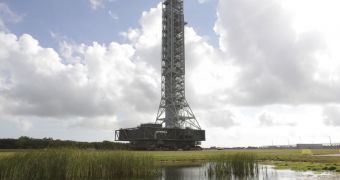When the American space agency was still pursuing Project Constellation, it also gave order to construct a mobile launcher (ML), a massive structure that was to be used to support the ARES rocket family. The completed ML was moved to its launch pad on Wednesday, November 16.
The giant structure is located at the NASA Kennedy Space Center, in Florida. It was scheduled to begin structural and functional testing at the installation's Launch Pad 39B facility some time ago, but it was only recently that engineers at the Center got around to this.
The agency now plans to use the ML as a support structure for the Space Launch System (SLS), the next-generation rocket currently being developed for space exploration. The vehicle is a highly-adaptable delivery system, which will be able to achieve a host of different capabilities.
Though the first SLS prototype is scheduled to fly no earlier than 2017, NASA wants to have the ML prepared. This is why the platform is now beginning its two-week trial period at the KSC. The main goal here is to figure out how its systems cooperate with those already installed at LP-39B.
Over the past year, this launch pad underwent a significant number of modifications. Work here began in 2009, when Project Constellation still called for ARES I-X and ARES I test flights to be conducted from Florida. At this point, the installation has none of the equipment previously used by the shuttles.
The ML is perched above one of NASA's three Mobile Launch Platforms, vehicles that have been in use for decades. The main feature of the new structure is the 400-foot (122-meter) tower, which is the largest one the space agency constructed since the Apollo Program.
In fact, the SLS will be in the same lifting category as the Saturn V rocket that carried the Apollo capsules to the Moon. KSC experts believe that the ML can be modified to suit the launch of the new rocket without too many problems.
“We have the time and will be able to gain significant knowledge that will assist in the development of the ML,” explains ML project manager, Larry Schultz. The platform took 14 hours to reach LP-39B, after beginning its 4.2-mile (6.8-kilometer) trip at 9.15 am EST (1415 GMT).
The ML will remain at LP-39B for just a couple of weeks, during which time engineers will run a large series of compatibility tests. The work will establish whether any hardware modifications are in order in the short term, so as to improve the compatibility between the launch pad and the platform.
There are still numerous systems to be added to the platform, and NASA hopes that the new tests will highlight aspects of the planned modifications that its experts did not think of. Over the next few years, the ML will be moved back and forth at the KSC, as more tests will be conducted on its new systems.

 14 DAY TRIAL //
14 DAY TRIAL //